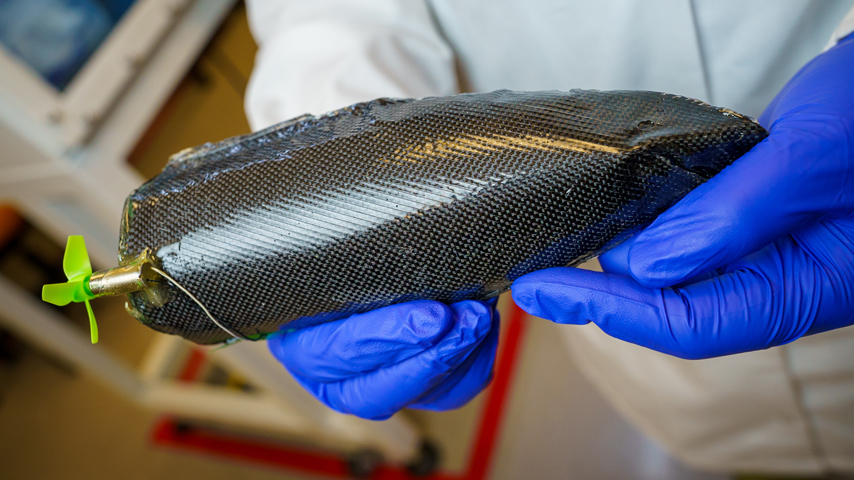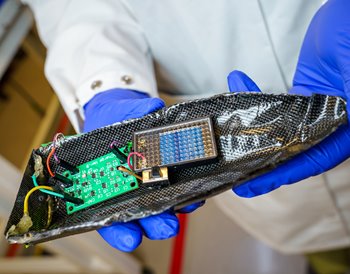New Material Combines Strength and Energy Storage
New Material Combines Strength and Energy Storage


Imagine an EV that stores electricity in its chassis. Researchers at the University of California, San Diego, have developed a structural supercapacitor that could enable that and more.
Imagine your phone’s case was made from a material that allowed you to charge your device and extend the time between recharging cycles. Tse Nga (Tina) Ng, a professor of electrical and computer engineering at the University of California, San Diego, led a team in collaboration with colleague Xinyu Zhang, to develop such a material, which they call a structural supercapacitor. It provides structural support and stores and delivers energy.
A supercapacitor is a device that stores electricity like a battery but can discharge much faster and can be recharged for far more cycles. While supercapacitors are good at delivering energy but are not strong building materials.
Making a supercapacitor with enough strength to use as structural components for a car would provide the most efficient use of space, Ng said, and enable vehicles to drive longer on a single charge.
To understand the role of a structural supercapacitor in meeting energy demands, it helps to picture a tank with a hose attached to it. The size of the tank will determine its energy density, while the size of the hose will dictate the component’s power density. In an ideal world, you want both a lot of energy (a large tank) and the ability to draw on that energy quickly (a wide hose).
Ng’s work on the structural supercapacitor is a lesson in how tradeoffs work in engineering and knowing which factors to advance first. Ng and her team’s research focused on improving material strength and power density (the size of the hose) so the energy could be accessed faster.
Joining ASME is Easy
The supercapacitor the UCSD team developed follows the traditional model of two electrodes and an electrolyte connecting the two. What makes it a structural supercapacitor is the materials used and the way in which they are distributed. A conductive polymer coats the surface electrodes and a layered gradient in the electrolyte develops the necessary interfaces to improve strength and power density.
To improve power density you need to “grab the charge quickly,” Ng said, which means it would help to have it readily available closer to the surface.
Ng achieved that by increasing the energy storage capacity and ion flow close to the electrodes. First the team coated the carbon-fiber composite electrodes with a conductive polymer. (Prior work used plain carbon-fiber composites for the electrodes but improved conductivity through physical modification of the surfaces via etching or some other means. But these methods weakened the structural strength of the electrodes). To further increase energy storage capacity and ion flow, Ng modified the solid electrolyte, a mix of epoxy resin and polyethylene oxide, closer to the electrodes.
More on Energy Storage: A Battery in the Eye
While such a move helped with energy capacity and flow, it weakened the structure by introducing more pores. To make up for lost strength near the electrodes, Ng and team decreased the concentration of the solid electrolyte in the middle of the structure. Such a gradient delivered the best of both worlds: higher power density and overall improved strength.
As a demonstration of the concept, Ng’s team molded the structural supercapacitor into the shape of a small boat. Many boats are made from carbon fiber-reinforced composites, so the team would be working with material already in use. Also, the boat has an onboard motor, so the team wanted to show how the structural supercapacitor would be able to drive the motor—as the team was indeed able to do.
Future research will focus on making thicker composites which might help in further improving rigidity and mechanical strength. The team will also explore ways of improving energy storage capacity. It’s a constant battle between power output versus energy, Ng said. The ultimate goal, Ng added, would be to achieve both higher power and energy densities.
Editor's Choice: Common Materials Make Supercapacitor
Cost might be another factor the team will have to consider as such multifunctional products are usually expensive to manufacture.
But the research could make a difference in solutions to address climate change.
“Renewable energy generation is great, but we need to store it at night because there is no generation happening at night,” Ng said. Such supercapacitors help address related energy storage and delivery challenges too.
In addition, devices that operate for longer without the need for a recharge would be a boon. “A lot of the surfaces on electronic devices right now, we use them only to protect but what if we can also use them to store energy? Maybe then we could have our laptops run even longer,” Ng said.
Poornima Apte is a technology writer in Walpole, Mass.

A supercapacitor is a device that stores electricity like a battery but can discharge much faster and can be recharged for far more cycles. While supercapacitors are good at delivering energy but are not strong building materials.
Making a supercapacitor with enough strength to use as structural components for a car would provide the most efficient use of space, Ng said, and enable vehicles to drive longer on a single charge.
To understand the role of a structural supercapacitor in meeting energy demands, it helps to picture a tank with a hose attached to it. The size of the tank will determine its energy density, while the size of the hose will dictate the component’s power density. In an ideal world, you want both a lot of energy (a large tank) and the ability to draw on that energy quickly (a wide hose).
Ng’s work on the structural supercapacitor is a lesson in how tradeoffs work in engineering and knowing which factors to advance first. Ng and her team’s research focused on improving material strength and power density (the size of the hose) so the energy could be accessed faster.
Joining ASME is Easy
The supercapacitor the UCSD team developed follows the traditional model of two electrodes and an electrolyte connecting the two. What makes it a structural supercapacitor is the materials used and the way in which they are distributed. A conductive polymer coats the surface electrodes and a layered gradient in the electrolyte develops the necessary interfaces to improve strength and power density.
To improve power density you need to “grab the charge quickly,” Ng said, which means it would help to have it readily available closer to the surface.
Ng achieved that by increasing the energy storage capacity and ion flow close to the electrodes. First the team coated the carbon-fiber composite electrodes with a conductive polymer. (Prior work used plain carbon-fiber composites for the electrodes but improved conductivity through physical modification of the surfaces via etching or some other means. But these methods weakened the structural strength of the electrodes). To further increase energy storage capacity and ion flow, Ng modified the solid electrolyte, a mix of epoxy resin and polyethylene oxide, closer to the electrodes.
More on Energy Storage: A Battery in the Eye
While such a move helped with energy capacity and flow, it weakened the structure by introducing more pores. To make up for lost strength near the electrodes, Ng and team decreased the concentration of the solid electrolyte in the middle of the structure. Such a gradient delivered the best of both worlds: higher power density and overall improved strength.
As a demonstration of the concept, Ng’s team molded the structural supercapacitor into the shape of a small boat. Many boats are made from carbon fiber-reinforced composites, so the team would be working with material already in use. Also, the boat has an onboard motor, so the team wanted to show how the structural supercapacitor would be able to drive the motor—as the team was indeed able to do.
Future research will focus on making thicker composites which might help in further improving rigidity and mechanical strength. The team will also explore ways of improving energy storage capacity. It’s a constant battle between power output versus energy, Ng said. The ultimate goal, Ng added, would be to achieve both higher power and energy densities.
Editor's Choice: Common Materials Make Supercapacitor
Cost might be another factor the team will have to consider as such multifunctional products are usually expensive to manufacture.
But the research could make a difference in solutions to address climate change.
“Renewable energy generation is great, but we need to store it at night because there is no generation happening at night,” Ng said. Such supercapacitors help address related energy storage and delivery challenges too.
In addition, devices that operate for longer without the need for a recharge would be a boon. “A lot of the surfaces on electronic devices right now, we use them only to protect but what if we can also use them to store energy? Maybe then we could have our laptops run even longer,” Ng said.
Poornima Apte is a technology writer in Walpole, Mass.

Explore R&D Pulse
From interactive infographics to interviews with article authors, this benefit spotlights cutting-edge research from ASME journals.






